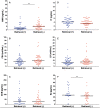Anti-Müllerian hormone predicts positive sperm retrieval in men with idiopathic non-obstructive azoospermia-findings from a multi-centric cross-sectional study
- PMID: 37322566
- PMCID: PMC10482483
- DOI: 10.1093/humrep/dead125
Anti-Müllerian hormone predicts positive sperm retrieval in men with idiopathic non-obstructive azoospermia-findings from a multi-centric cross-sectional study
Abstract
Study question: Is it possible to identify a reliable marker of successful sperm retrieval (+SR) in men with idiopathic non-obstructive azoospermia (iNOA) undergoing microdissection testicular sperm extraction (mTESE)?
Summary answer: A higher likelihood of +SR during mTESE is observed in men with iNOA and lower preoperative serum anti-Müllerian hormone (AMH) levels, with good predictive accuracy achieved using an AMH threshold of <4 ng/ml.
What is known already: AMH has been previously linked to +SR in men with iNOA undergoing mTESE prior to ART.
Study design, size, duration: A multi-centre cross-sectional study was carried out with a cohort of 117 men with iNOA undergoing mTESE at three tertiary-referral centres.
Participants/materials, setting, methods: Data from 117 consecutive white-European men with iNOA presenting for primary couple's infertility associated with a pure male factor at three centres were analysed. Descriptive statistics was applied to compare patients with negative (-SR) versus +SR at mTESE. Multivariate logistic regression models were fitted to predict +SR at mTESE, after adjusting for possible confounders. Diagnostic accuracy of the factors associated with +SR was assessed. Decision curve analyses were used to display the clinical benefit.
Main results and the role of chance: Overall, 60 (51.3%) men had an -SR and 57 (48.7%) had a +SR at mTESE. Patients with +SR had lower levels of baseline AMH (P = 0.005) and higher levels of estradiol (E2) (P = 0.01). At multivariate logistic regression analysis, lower levels of AMH (odds ratio: 0.79; 95% CI: 0.64-0.93, P = 0.03) were associated with +SR at mTESE, after adjusting for possible confounders (e.g. age, mean testicular volume, FSH, and E2). A threshold of AMH <4 ng/ml achieved the highest accuracy for +SR at mTESE, with an AUC of 70.3% (95% CI: 59.8-80.7). Decision curve analysis displayed the net clinical benefit of using an AMH <4 ng/ml threshold.
Limitations, reasons for caution: There is a need for external validation in even larger cohorts, across different centres and ethnicities. Systematic reviews and meta-analysis to provide high level of evidence are lacking in the context of AMH and SR rates in men with iNOA.
Wider implications of the findings: Current findings suggest that slightly more than one in two men with iNOA had -SR at mTESE. Overall, men with iNOA with lower levels of AMH had a significantly higher percentage of successful SR at surgery. A threshold of <4 ng/ml for circulating AMH ensured satisfactory sensitivity, specificity, and positive predictive values in the context of +SR at mTESE.
Study funding/competing interest(s): This work was supported by voluntary donations from the Urological Research Institute (URI). All authors declare no conflict of interest.
Trial registration number: N/A.
Keywords: anti-Müllerian hormone; idiopathic azoospermia; microsurgical testicular sperm extraction; sperm retrieval; testosterone.
© The Author(s) 2023. Published by Oxford University Press on behalf of European Society of Human Reproduction and Embryology. All rights reserved. For permissions, please email: journals.permissions@oup.com.
Conflict of interest statement
The authors declare no conflict of interest.
Figures



References
-
- Aboukhshaba A, Punjani N, Doukakis S, Schlegel PN.. Anti-Müllerian hormone level as a predictor of sperm retrieval with microdissection testicular sperm extraction in nonobstructive azoospermia. Andrologia 2021;53:e14220. - PubMed
-
- Achermann APP, Pereira TA, Esteves SC.. Microdissection testicular sperm extraction (micro-TESE) in men with infertility due to nonobstructive azoospermia: summary of current literature. Int Urol Nephrol 2021;53:2193–2210. - PubMed
-
- Alfano M, Ventimiglia E, Locatelli I, Capogrosso P, Cazzaniga W, Pederzoli F, Frego N, Matloob R, Saccà A, Pagliardini L. et al. Anti-Mullerian hormone-to-testosterone ratio is predictive of positive sperm retrieval in men with idiopathic non-obstructive azoospermia. Sci Rep 2017;7:17638. - PMC - PubMed
Publication types
MeSH terms
Substances
Supplementary concepts
LinkOut - more resources
Full Text Sources
Medical
Research Materials

